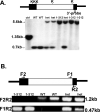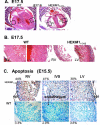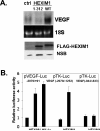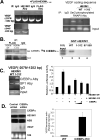Mutation of the HEXIM1 gene results in defects during heart and vascular development partly through downregulation of vascular endothelial growth factor
- PMID: 18079413
- PMCID: PMC2905161
- DOI: 10.1161/CIRCRESAHA.107.157859
Mutation of the HEXIM1 gene results in defects during heart and vascular development partly through downregulation of vascular endothelial growth factor
Abstract
Our previous studies and those of others indicated that the transcription factor Hexamethylene-bis-acetamide-inducible protein 1 (HEXIM1) is a tumor suppressor and cyclin-dependent kinase inhibitor, and that these HEXIM1 functions are mainly dependent on its C-terminal region. We provide evidence here that the HEXIM1 C-terminal region is critical for cardiovascular development. HEXIM1 protein was detected in the heart during critical time periods in cardiac growth and chamber maturation. We created mice carrying an insertional mutation in the HEXIM1 gene that disrupted its C-terminal region and found that this resulted in prenatal lethality. Heart defects in HEXIM1(1 to 312) mice included abnormal coronary patterning and thin ventricular walls. The thin myocardium can be partly attributed to increased apoptosis. Platelet endothelial cell adhesion molecular precursor-1 staining of HEXIM1(1 to 312) heart sections revealed decreased vascularization of the myocardium despite the presence of coronary vasculature in the epicardium. The expression of vascular endothelial growth factor (VEGF), known to affect angioblast invasion and myocardial proliferation and survival, was decreased in HEXIM1(1 to 312) mice compared with control littermates. We also observed decreased fibroblast growth factor 9 (FGF9) expression, suggesting that effects of HEXIM1 in the myocardium are partly mediated through epicardial FGF9 signaling. Together our results suggest that HEXIM1 plays critical roles in coronary vessel development and myocardial growth. The basis for this role of HEXIM1 is that VEGF is a direct transcriptional target of HEXIM1, and involves attenuation a repressive effects of C/EBPalpha on VEGF gene transcription.
Figures






Comment in
-
Vascular endothelial growth factor gene regulation by HEXIM1 in heart.Circ Res. 2008 Feb 29;102(4):398-400. doi: 10.1161/CIRCRESAHA.108.172114. Circ Res. 2008. PMID: 18309107 No abstract available.
Similar articles
-
Endocardial cushion morphogenesis and coronary vessel development require chicken ovalbumin upstream promoter-transcription factor II.Arterioscler Thromb Vasc Biol. 2012 Nov;32(11):e135-46. doi: 10.1161/ATVBAHA.112.300255. Epub 2012 Sep 6. Arterioscler Thromb Vasc Biol. 2012. PMID: 22962329 Free PMC article.
-
HEXIM1 modulates vascular endothelial growth factor expression and function in breast epithelial cells and mammary gland.Oncogene. 2010 Jun 24;29(25):3639-49. doi: 10.1038/onc.2010.110. Epub 2010 May 10. Oncogene. 2010. PMID: 20453883 Free PMC article.
-
Down-regulation of hypoxia-inducible factor-1 alpha and vascular endothelial growth factor by HEXIM1 attenuates myocardial angiogenesis in hypoxic mice.Biochem Biophys Res Commun. 2014 Oct 24;453(3):600-5. doi: 10.1016/j.bbrc.2014.09.135. Epub 2014 Oct 6. Biochem Biophys Res Commun. 2014. PMID: 25301555
-
Role of the vascular endothelial growth factor isoforms in retinal angiogenesis and DiGeorge syndrome.Verh K Acad Geneeskd Belg. 2005;67(4):229-76. Verh K Acad Geneeskd Belg. 2005. PMID: 16334858 Review.
-
Epicardial-myocardial signaling directing coronary vasculogenesis.Circ Res. 2010 Mar 19;106(5):818-32. doi: 10.1161/CIRCRESAHA.109.209197. Circ Res. 2010. PMID: 20299672 Free PMC article. Review.
Cited by
-
Genome-wide association study identifies eight loci associated with blood pressure.Nat Genet. 2009 Jun;41(6):666-76. doi: 10.1038/ng.361. Epub 2009 May 10. Nat Genet. 2009. PMID: 19430483 Free PMC article.
-
Cardiac lineage protein-1 (CLP-1) regulates cardiac remodeling via transcriptional modulation of diverse hypertrophic and fibrotic responses and angiotensin II-transforming growth factor β (TGF-β1) signaling axis.J Biol Chem. 2012 Apr 13;287(16):13084-93. doi: 10.1074/jbc.M111.288944. Epub 2012 Feb 3. J Biol Chem. 2012. PMID: 22308025 Free PMC article.
-
Thyroid hormone enhanced human hepatoma cell motility involves brain-specific serine protease 4 activation via ERK signaling.Mol Cancer. 2014 Jul 1;13:162. doi: 10.1186/1476-4598-13-162. Mol Cancer. 2014. PMID: 24980078 Free PMC article.
-
Inducible re-expression of HEXIM1 causes physiological cardiac hypertrophy in the adult mouse.Cardiovasc Res. 2013 Jul 1;99(1):74-82. doi: 10.1093/cvr/cvt086. Epub 2013 Apr 11. Cardiovasc Res. 2013. PMID: 23585471 Free PMC article.
-
Genetics and Molecular Basis of Congenital Heart Defects in Down Syndrome: Role of Extracellular Matrix Regulation.Int J Mol Sci. 2023 Feb 2;24(3):2918. doi: 10.3390/ijms24032918. Int J Mol Sci. 2023. PMID: 36769235 Free PMC article. Review.
References
-
- Kusuhara M, Nagasaki K, Kimura K, Maass N, Manabe T, Ishikawa S, Aikawa M, Miyazaki K, Yamaguchi K. Cloning of Hexamethylene-bis-acetamide-inducible transcript, HEXIM1, in human vascular smooth muscle cells. Biomedical Res. 1999;20:273–279.
-
- Wittmann BM, Wang N, Montano MM. Identification of a novel inhibitor of cell growth that is down-regulated by estrogens and decreased in breast tumors. Cancer Res. 2003;63:5151–5158. - PubMed
-
- Wittmann BM, Fujinaga K, Deng H, Ogba N, Montano MM. The breast cell growth inhibitor, estrogen down regulated gene 1, modulates a novel functional interaction between estrogen receptor alpha and transcriptional elongation factor cyclin T1. Oncogene. 2005;24:5576–5588. - PubMed
-
- Huang F, Wagner M, Siddiqui MA. Structure, expression, and functional characterization of the mouse CLP-1 gene. Gene. 2002;292:245–259. - PubMed
Publication types
MeSH terms
Substances
Grants and funding
LinkOut - more resources
Full Text Sources
Medical
Molecular Biology Databases
Research Materials
Miscellaneous

